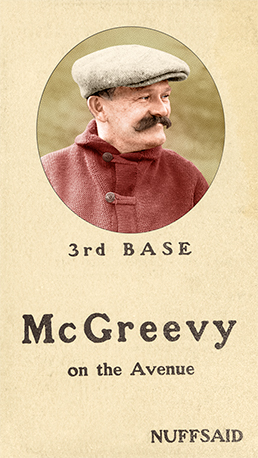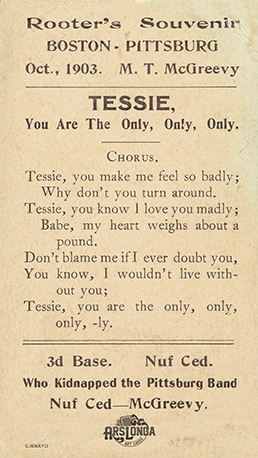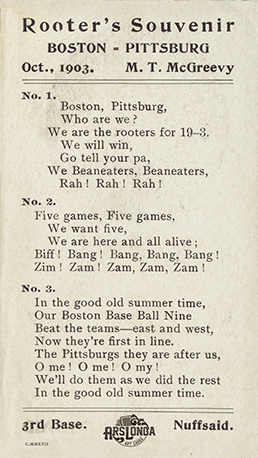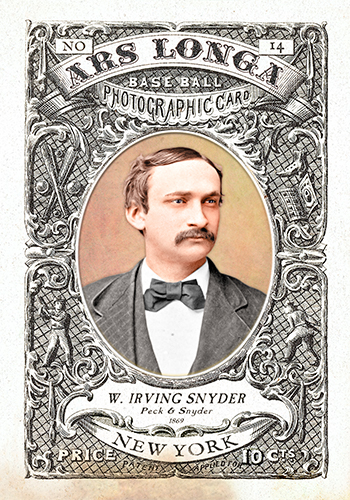
- Series: Mort's Reserve
- City: New York
Walter Irving Snyder and his partner Andrew Peck founded the first true sporting goods store in 1866 at 124-128 Nassau Street in New York City. The pair wanted to promote their business and thought trade cards might help. In 1869, this was a common technique for many retailers, but Peck and Snyder wanted something distinctive. They came up with the idea of using the image of Harry Wright’s nationally renowned new professional baseball squad, the Cincinnati Red Stockings, as their motif. A few versions were printed, the most prized of which today features the players in uniform and their names below the photo. No one could have known that this modest marketing scheme would pave the way for one of the great products and hobbies in American history, as Peck and Snyder unwittingly established a framework for the mass-produced baseball picture card. Following the Red Stockings release, the company issued cards featuring the hometown Mutuals and rival Chicago White Stockings in 1870. Other manufacturers soon followed suit and baseball cards became an advertising mainstay.
Snyder forged a fortuitous relationship with baseball-star-turned-entrepreneur Al Spalding. Irving joined the 1888 “Spalding’s World Tour” to help promote his business interests (and find a buyer for 30,000 pairs of roller skates, per Jerry Houseman of Sports Collectors Daily). The friendship with Spalding later led to Al buying out Peck and Snyder, allowing the founders to devote themselves to manufacturing.
- In a memoir of the ‘88 tour, Snyder wrote of playing the game for “about 200 Arabs” in the shadows of the pyramids. He was pleased to note that, unlike the English, the Egyptians never once referred to baseball as “really just Rounders, you know.”
- In the 1913 edition of Spalding’s “official base ball guide,” his old pal Snyder penned a promo: “I have read the book from cover to cover with great interest.”
- Snyder is credited by Aussie cricketer gear manufacturer BaggyCaps as having invented the cap cricketers proudly sport today, acknowledging it was created for baseball. Thus Irving helped bring full circle the influence of British “rounders” and America’s pastime
- A Peck & Snyder 1869 Cincinnati Red Stockings card recently sold for $75,000
Following in his older brother’s footsteps, Ward B. Snyder established a sporting goods store at 84 Fulton St. in New York City in 1875. The annually published Ward B. Snyder’s Illustrated Price List and Catalogue of Base Ball and Sportsmen’s Goods is a highly prized collectible today and is a fantastic color documentary of baseball uniforms and equipment of the 1870s.
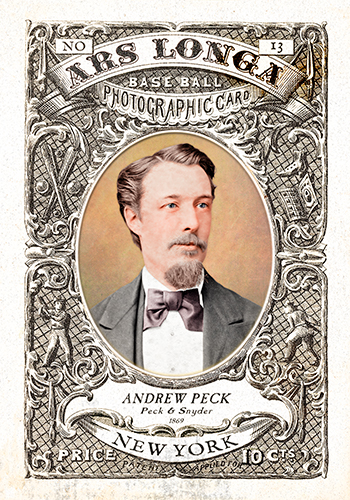
- Series: Mort's Reserve
- City: New York
Andrew Peck (1836-1918) and his partner Walter Irving Snyder founded the first true sporting goods store in 1866 at 124-128 Nassau Street in New York City. The pair wanted to promote their business and thought trade cards might help. In 1869, this was a common technique for many retailers, but Peck and Snyder wanted something distinctive. They came up with the idea of using the image of Harry Wright’s nationally renowned new professional baseball squad, the Cincinnati Red Stockings, as their motif. A few versions were printed, the most prized of which today features the players in uniform and their names below the photo. No one could have known that this modest marketing scheme would pave the way for one of the great products and hobbies in American history, as Peck and Snyder unwittingly established a framework for the mass-produced baseball picture card. Following the Red Stockings release, the company issued cards featuring the hometown Mutuals and rival Chicago White Stockings in 1870. Other manufacturers soon followed suit and baseball cards became an advertising mainstay.
- Peck posted inning-by-inning telegraph reports of the big game between the NY Mutuals and Wright’s club in 1870 to a fevered crowd of NY “cranks.” Final tally: Cincinnati 15, NY 12.
- Peck started his business with ten cents to his name and died a rich man
- Perhaps not rich enough to buy his own trade cards today though: a Peck & Snyder 1869 Cincinnati Red Stockings card recently sold for $75,000
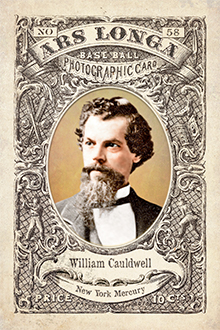
- Series: Pioneer Portraits I: 1850-1874
- City: New York
William Pierce Cauldwell (1824-1907) was, per the New York Tribune’s obituary, “the father of Sunday journalism.” More significantly for baseball, Cauldwell was the first publisher to dedicate regular space and ink to the game of baseball as news (starting in 1853), while also serving as mentor to the “Father of Baseball,” Henry Chadwick, whom he hired in 1858 to report on the new “national pastime” - a phrase Cauldwell’s Sunday Mercury newspaper coined on December 5, 1856.
Cauldwell had begun as a typesetter in 1841 before becoming publisher of the Sunday Mercury in NYC. In 1853 he began covering the games between the Knickerbockers and Gothams, introducing a wide audience to this phenomenon of outdoor athletics. He charted its course, reporting on the exponential growth of clubs all over the country. In his summary of the game in 1860, Cauldwell’s column no longer was long enough to list all the teams. He noted that California had seen its first game played on Feb 22 of that year.
- Cauldwell was active in politics, serving in the NY Senate and State Assembly as well as being a Supervisor of The Bronx before its annexation into NY City


